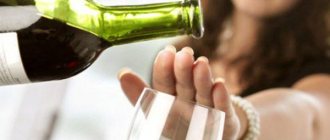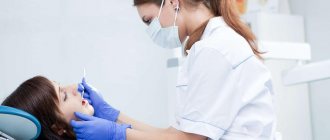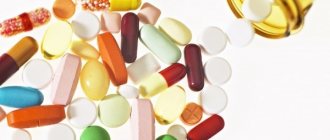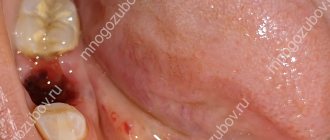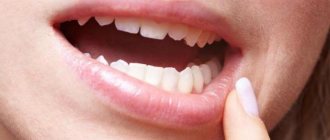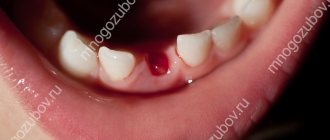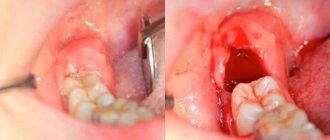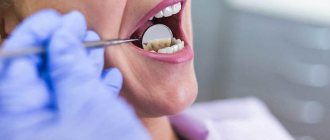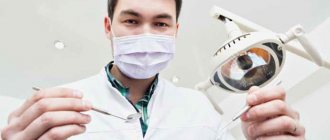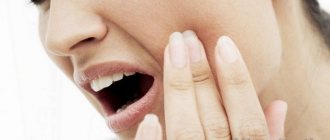Removal - tooth extraction - is an unpleasant, but sometimes necessary procedure.
How to behave after surgery to avoid complications?
Is it possible to rinse immediately after removal?
What drugs should I buy at the pharmacy? These and other questions are asked by people at the dentist's office.
When to start
It is recommended to start rinsing your mouth 2–3 days after extraction. Why not earlier? To avoid washing out the blood clot.
If the clot is washed out, a serious complication may develop - alveolitis - inflammation that will require long-term therapy.
After tooth extraction:
- For the first two hours you should not drink or eat, especially hot food.
- Smoking and drinking alcohol are prohibited.
- You can gently, if necessary, brush your teeth without touching the socket.
- Every other day you can do baths, after two days - rinses.
Mouth rinse after removing figure eights
Dentists advise starting to rinse your mouth only on the fourth day after wisdom tooth removal. It is prohibited to drink alcohol, drink strong tea and other caffeinated drinks. It is necessary to cool the operated gum area for 24 hours to reduce the risk of severe swelling.
It is necessary to rinse the mouth with water to clean the open wound and prevent it from becoming infected. To do this, it is advisable to use an irrigator. You should also rinse your mouth after every meal. After removing a “wise” tooth, it is recommended to rinse the mouth with soda or Chlorhexidine.
Sometimes the wounds formed as a result of extraction cause intense pain that prevents regular brushing of the teeth. In this case, doctors advise rinsing your mouth with a solution containing chlorhexidine. This effective antiseptic is often used in dentistry; it is needed to reduce the growth of pathogenic microflora and the intensity of the inflammatory process.
The active substance Chlorhexidine prevents the formation of plaque, which makes it possible to replace standard tooth brushing by wiping the enamel with gauze pads or cotton swabs soaked in this solution.
The use of an antiseptic containing chlorhexidine is prohibited during the first 48 hours after extraction. During this period, you should never use an alcohol preparation, because alcohol has a powerful blood-thinning effect. The particularly strong anticoagulant effect of the drug increases the risk of re-bleeding at the site of wisdom tooth extraction.
During intense sports training and intense physical stress, pressure increases, so secondary hemorrhages may occur. For this reason, doctors usually prohibit exercise in the first days after extraction, especially when removing the figure eight.
Medications
There are many pharmaceuticals and traditional medicine recipes. The dentist will definitely select the medications that are suitable for a particular patient.
Chlorhexidine
Chlorhexidine is a universal antiseptic used in modern medicine for the treatment and prevention of purulent-inflammatory processes caused by bacteria and viruses.
Chlorhexidine is used as a rinse for gum inflammation after tooth extraction.
To rinse, you need to prepare a half-percent solution:
- take 0.05 g of chlorhexidine bigluconate and 100 ml of water;
- a ready-made solution of 0.05% can be bought at a pharmacy.
The pharmaceutical solution can be used directly. For children, in order to avoid burns to the mucous membrane, the solution should be diluted one to two.
Dentists recommend rinsing your mouth or using baths after tooth extraction three times a day. For one rinse or bath, 15 ml of product is enough.
Contraindications and side effects: the instructions say that chlorhexidine should not be used for dermatitis or hypersensitivity to the drug.
Miramistin
Miramistin is a solution that has a wide spectrum of immunomodulatory and wound-healing effects. Active against pathogenic microflora, fungi and viruses.
The solution is safe for humans and can be used repeatedly. At the pharmacy, if prescribed by a doctor, you can buy 0.01% with a spray nozzle for the oral cavity.
How to use? You need to point the nozzle towards the hole of the avulsed tooth, press the sprayer 1-2 times, trying not to damage the blood clot.
If the pharmacy sold a solution without a nozzle, you can simply make baths. Contraindications: allergic reaction to the components of the medication.
Furacilin
Rinsing with furatsilin is recommended for purulent complications after extraction.
The pharmacy sells a sterile 0.02% solution of furatsilin. But you can also use tablets: dissolve ten tablets in a liter of boiled water.
In order not to wash away the blood clot, the solution must be kept in the mouth for several minutes so that the medicine is absorbed into the hole. Repeat the procedure at least 4 times a day.
Potassium permanganate
Rinsing with potassium permanganate is allowed, but it is very problematic for two reasons:
- Potassium permanganate has been available by prescription only since 2007.
- Some patients diluted potassium permanganate incorrectly and received serious chemical burns.
When diluting potassium permanganate for rinsing, a slightly pink solution is prepared. You need to make sure that not a single grain remains in the solution. The slightest grain is a big problem for the burned oral mucosa.
Chlorophyllipt
It is prescribed for rinsing if, on the 5th – 7th day after extraction, a white coating with a yellowish tint and a viscous cloudy discharge appears on the gums.
The product has a bacteriostatic (suppresses the proliferation of bacteria) and bactericidal (destroys) effect, and is active against staphylococcal infections.
A contraindication to the use of chlorophyllipt is an allergic reaction to essential oil and eucalyptus, the components of the drug. Therefore, before using the medicine, you need to carry out a test - do one press of the spray on the elbow.
If a burning sensation appears within 6–8 hours, the drug should not be taken.
Salvin
Salvin is called a local antibiotic. The drug is obtained from sage and oil extracts of some herbs.
The pharmacotherapeutic effect of salvin has not yet been sufficiently studied, but it is well known that the drug exhibits bactericidal and tanning properties.
Stomatophyte
Stomatofit is a phytopreparation with anti-inflammatory, antimicrobial, fungicidal and astringent action. Composition of the drug: extracts of chamomile, sage, oak bark.
Directions for use: 10 mg of stomatophyte should be dissolved in a quarter glass of water at room temperature.
It is recommended to rinse 3-4 times a day. Afterwards you cannot eat or drink for about 30 minutes.
The drug is not recommended for children under 6 years of age, pregnant women, or those with hypersensitivity to the components. The drug is available in dark glass bottles.
Why rinse your mouth after tooth extraction?
The necessary conditions for the proliferation of pathogenic microorganisms are: the presence of moisture and nutrients, the environmental temperature is from 36 to 40 degrees. The oral cavity has all the factors that contribute to the active functioning of pathogenic microflora. In order for the gums to heal without postoperative consequences, dentists recommend rinsing your mouth with antibacterial agents.
Indications
Intraoral rinses without any reason will not bring the desired benefit. If the patient does not have chronic diseases and follows all the rules for caring for teeth and gums, there is no need to rinse the wound with medicinal substances.
Therapeutic treatment of gums after tooth extraction is required in the following cases:
- the presence of multiple carious lesions;
- the presence of abundant plaque and tartar;
- inflammatory diseases of periodontal and periodontal tissues;
- deep damage to the gums during surgery;
- swelling of the gums, accompanied by throbbing pain;
- formation of a purulent focus;
- exit of an abscess at the site of an avulsed tooth.
When not to rinse your mouth
If indicated, the doctor must explain the principle of antiseptic treatment of the wound and when you can rinse your mouth after tooth extraction.
Medical recommendations indicate that rinsing the gums after tooth extraction in the first 3–4 hours is prohibited. With intensive wound treatment, the blood clot is washed out of the socket, which increases the rehabilitation period and increases the risk of gum infection.
Contraindications to medicinal gum rinses include:
- lack of prescriptions from the attending physician;
- absence of an inflammatory process at the site of the extracted tooth;
- prolonged bleeding caused by poor blood clotting.
Traditional medicine recipes for use at home
Dentists recommend rinsing after tooth extraction with decoctions and infusions only on days 5–7 to relieve swelling, residual pain, and clean the wound.
Herbs are used for uncomplicated wound healing. In some cases, the dentist may recommend rinsing on days 2–3.
Herbal infusions
Calendula, oak bark, chamomile, sage, eucalyptus are indispensable helpers in the fight for the cleanliness and health of the tooth socket.
A spoonful of any herb or mixture, brewed in a glass of water and cooled to room temperature, is used for hygienic rinsing of the mouth, destroys bacteria, relieves swelling and pain.
Rinsing with valerian decoction reduces irritation. Aloe juice diluted with water 1:2 accelerates regeneration processes.
Ordinary warm tea, thanks to the polyphenols it contains, inhibits the growth of bacteria.
Saline solutions
To speed up the healing of the hole, you can prepare a saline solution: 1 tsp. Dissolve table salt in warm water, hold the solution in your mouth for several minutes.
Some dentists recommend using iodized salt. The recipe is the same.
Soda solutions
A soda solution is recommended for extracted purulent teeth or the presence of a fistula in the gum. Baking soda perfectly relieves inflammation.
To achieve the best effect, it is recommended to use soda-salt solutions : take a teaspoon of salt and soda per glass of water.
What else can you rinse your mouth with after a tooth has been removed?
To prevent infection of the socket, you can use other popular and effective drugs and solutions:
- Miramistin. This is an antiseptic that can be used to rinse out bacterial particles that deposit the oral cavity. In addition, the medicine neutralizes yeast and even some viruses, increases the body's defenses and helps to quickly heal the wound without penetrating the circulatory system. Miramistin can be used to treat existing inflammation of the socket. The drug is safe for children and pregnant women.
- Soda and salt solutions. Such products are capable of disinfecting and healing the wound, preventing the formation of purulent exudate and flux. To prepare the correct solution, you need to take a cup of warm or cool water and add a teaspoon of soda and salt to it. You can also wash the well with a mixture of 5-6 drops of iodine and a teaspoon of salt dissolved in a glass of water. It is forbidden to rinse the hole with a hot solution, since this action will lead to the formation of a focus of inflammation and bleeding.
- Furacilin. To rinse the mouth after tooth extraction, you can use Furacilin solution. This drug has long been used as an excellent disinfectant that relieves inflammation and stops the formation of pus. It kills most harmful microorganisms and is effective in combating postoperative complications. To make the solution, you need to dilute two crushed tablets in a cup of hot water, and then add a little salt. To dissolve substances faster, you can heat the solution over low heat. You should rinse the injured gum with Furacilin three to four times a day.
The hole formed after a person's tooth was pulled out can be rinsed with a solution of potassium permanganate. This drug has long been used in medicine and is the best means for disinfecting wounds and eliminating suppuration. To prepare a solution of potassium permanganate, you need to add a few grains of the drug to a cup of water and stir the solution until they are completely dissolved. A more concentrated product can burn the oral mucosa and provoke the development of an allergic reaction.
Potassium permanganate solution.- Stomatophyte. The drug has pronounced anti-inflammatory, antibacterial and antifungal activity. In addition, it is used as an astringent, and it is also used to cure gumboil. Due to the alcohol contained in the drug, it is not recommended for the treatment of children under 6 years of age. To rinse a child’s mouth, you need to dilute the drug with water.
- Hydrogen peroxide. The product can only be used in diluted form. A spoonful of 3% solution is diluted in 100 ml of water.
Do not use a concentrated peroxide solution to rinse your mouth, otherwise the blood clot will dissolve. The hole in this case takes much longer to heal.
When preparing solutions for oral baths and rinses, it is necessary to observe proportions so as not to harm the process of hole formation and natural healing of the wound. You can rinse your mouth only on the third day after tooth extraction. Procedures should be short (1–2 minutes), but regular (3–5 times a day). It is equally important to carefully follow the instructions for those drugs that need to be diluted with water to the desired concentration.
How to carry out the procedure correctly
A few rules to follow:
- Use only those medications prescribed by your doctor for rinsing. Read the instructions, rules of use, determine if you have any contraindications.
- Test for an allergic reaction, especially if you are hypersensitive to many drugs.
- Rinse your mouth with warm water to remove any remaining food, then rinse with the medicine.
- Rinse your mouth after eating: put the medicine in your mouth, tilt your head towards the healing hole so that the solution gets on it. Hold the medicine for one to two minutes.
Gurgle and spit out the solution. Do not rinse aggressively so as not to remove the blood clot, do not rub the socket with your tongue, toothpicks, or brush.
- Repeat the procedure 3 – 4 times a day.
Treatment of infectious complications
Unpleasant sensations in the form of swelling and pain disappear on the third day after the intervention. During a complex operation, the temperature may rise slightly, which in the normal state is 36° - 37°. Complications often appear after a complex operation. They mean high temperature, severe pain, unstoppable bleeding, severe swelling, flux and the appearance of a purulent sac.
Important! If, after a tooth extraction operation, the temperature rises, a tugging pain, or severe swelling is bothersome, this is a serious reason to think about the complications of the postoperative period.
Complications can be caused by improper care of the cavity, incomplete removal of tooth remains, or complex surgery. To determine the cause of the complication and effectively eliminate the consequences, you must urgently consult a dentist. The temperature can be brought down with any antipyretic drugs. Paracetamol, Rapidol, Nurofen are suitable. You should not delay your visit to the doctor, otherwise the pathological process may spread to the nasopharynx, ears, eyes, neck and other organs. The dentist will eliminate the cause of the complication, carry out antiseptic treatment and prescribe appropriate treatment for the inflammatory process.
Antiseptic baths
Baths are a more gentle hygienic procedure than rinsing. Bath technique: take the medicine into your mouth, tilt your head towards the extracted tooth, hold for a couple of minutes, then spit out the liquid.
Baths are prescribed for the removal of carious teeth, inflammation, after opening an abscess or abscess.
Baths against the background of inflammation
Purulent inflammation is characterized by edema, swelling, and increasing pain. In such cases, baths with antiseptic solutions and antibiotics are recommended.
Lincomycin is usually prescribed for inflammation. The course of treatment is 5 – 7 days.
Baths after extraction for carious lesions of the mouth
Carious teeth are a source of infection, so baths after extraction are the main condition for rapid healing of the wound.
To prevent oral microorganisms from causing a blood clot to suppurate, antiseptic solutions are prescribed.
Baths after opening a purulent abscess
When opening an abscess and removing a tooth, the wound cavity is large, in some cases the dentist has to apply stitches. All this increases the likelihood of developing inflammation.
Baths with chlorhexidine, alternating with salt and soda, promote rapid healing and reduce the likelihood of complications.
Composition and indications for use
The drug is sold in pharmacies in the form of a gel, vaginal suppositories, and a 0.05% odorless, yellowish solution. According to the instructions, it is intended exclusively for external use. Contains the active ingredient - chlorhexidine bigluconate. There are also additional substances in the solution.
Chlorhexidine is a powerful antiseptic that is used in the event of diseases caused by harmful microorganisms and for preventive purposes: to heal wounds due to tooth extraction, relieve inflammation of the mucous membrane and in the fight against diseases of the oral cavity. The product is also indicated to prevent further development of gingivitis and periodontitis. Dentures are often treated with this solution.
Special cases
What does it mean - a special case? This is a feature of rinsing after tooth extraction in pregnant women, children, with gumboil, cyst, wisdom tooth removal:
- Pregnant women and children can be prescribed miramistin for rinsing, since the drug has no contraindications for this category of the population.
- After a tooth has been removed with flux, rinsing 4 to 5 times a day is mandatory, but only with the medications prescribed by the dentist. In severe cases, antibiotics are prescribed.
- Children need to be shown how to rinse their teeth correctly and explained that they should not swallow medicine. You should not prescribe bitter solutions to your child. It is imperative to monitor how the child copes with the task.
- After tooth and cyst removal, regular rinses are recommended.
- If the wisdom tooth extraction went without complications, rinsing is not needed at all. After complicated removal, rinsing is prescribed until the wound is completely healed.
Recommendations for oral care
During the first week after tooth extraction, high-quality oral care is required. There are special procedures that do not require much effort or time to follow. Follow the step-by-step instructions below and the healing period will go much faster.
Step 1. In the first few days after the procedure, it is not recommended to drink through a straw. This can damage the blood clot due to the high pressure that builds up in the mouth, which will slow down the recovery process.
Don't drink through a straw
Step 2: Drink plenty of fluids after removal. This will help maintain oral moisture and, as a result, prevent the development of many dental diseases. Avoid caffeinated drinks and soda for at least a few days after your tooth extraction.
Drink plenty of fluids
Step 3. Avoid drinks that are too hot, which can damage the blood clot that protects the socket from infection. We are talking about cocoa, coffee or tea.
Avoid hot drinks
Step 4. Add more liquid and soft foods to your daily diet. Avoid eating foods that may slow down healing by getting into the socket of the removed figure eight. Chew food on the other side of your jaw if possible, and rinse your mouth with a warm saline solution after each meal.
Increase the amount of soft food
Step 5. Quit smoking at least for the recovery period. The fact is that nicotine negatively affects the health of the gums, slowing down the blood circulation process. Nicotine can also lead to various complications such as infection, dental caries and other health problems.
Give up bad habits
Step 6: Relieve swelling and pain after tooth extraction using a cold compress. To do this, you need to apply several ice cubes wrapped in a towel to your cheek. As a rule, it takes 2-3 days for the swelling to completely disappear, so during this period it is not recommended to subject yourself to heavy physical activity. That is, during the healing period, you can forget about visiting the gym (if you go there, of course).
Apply cold compresses
On a note! If you are unable to bear the pain after removal, you can take a pain reliever. Nonsteroidal anti-inflammatory drugs, such as Naproxen or Ibuprofen, are suitable for this. If they do not help relieve pain, you should consult a doctor for help. After an examination, he will prescribe stronger drugs.
Nonsteroidal inflammatory drugs
Vodka and alcohol: can they be used?
Alcohol is believed to relieve pain. Well, we can agree with this, but not in this case.
This is relevant if a person deliberately wants to harm his health, because alcohol:
- It can cause the blood clot to dissolve, which means that the hole will be defenseless under the onslaught of food and microorganisms.
- It will cause vasodilation and access of microorganisms to tissues and blood, which will provoke bleeding.
- It will cause a chemical burn to exposed tissue and painful shock.
- Not compatible with certain medications, which may cause unwanted side effects.
What patients say
On the pages of our website, please share your reviews about the procedure for tooth extraction in clinics in your city or region.
Have you felt pain during tooth extraction? How quickly was the procedure? What rinses and baths did your dentist prescribe for you? Were you satisfied with the quality of assistance provided? Have you solved all the problems?
Your opinion is important to us. We wish you to maintain strong, healthy teeth and a beautiful smile.
If you find an error, please select a piece of text and press Ctrl+Enter.
What is Chlorhexidine?
"Chlorhexidine" is a clear liquid with a characteristic odor of ethyl alcohol, which has antimicrobial and antibacterial effects. The drug is used for antiseptic treatment of the skin and mucous membranes after surgical operations, for accidental injuries and injuries accompanied by a violation of the integrity of the skin: scratches, cuts, abrasions. The product can be used to disinfect hands if it is not possible to provide standard hygienic treatment with water and soap.
The mechanism of action of the drug on the bacterial cell
The active ingredient of the antiseptic is chlorhexidine in the form of bigluconate. The drug is available in several dosage forms for local and external treatment:
- spray;
- solution;
- vaginal suppositories (suppositories).
In dentistry, Chlorhexidine is used in the form of a spray and solution. It is used to treat hands, medical instruments, and is also used to disinfect the oral cavity after dental treatment using surgical methods. The effect of the drug lasts up to four hours after use.
"Chlorhexidine"
The active substance is active against most pathogenic microorganisms, which include gram-negative and gram-positive bacteria, various groups of viruses, yeast-like fungi, and dermatophytes. Chlorhexidine is especially effective for the prevention of dental infections caused by chlamydia and trichomonas.
"Chlorhexidine" after tooth extraction
